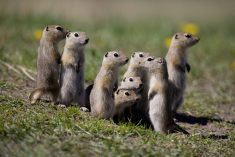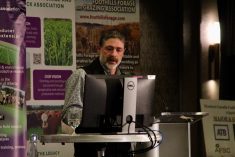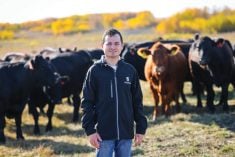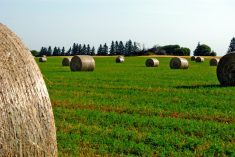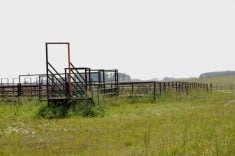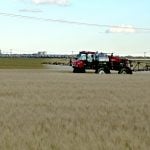If your grasslands are in good health, you’re already on your way to preventing an infestation of an invasive grass species.
Without proper range management, grasslands in poor condition will be less resistant to an unwanted species establishing, says Sheryl Wurtz, invasive plant specialist with the B.C. Ministry of Forests, Lands and Natural Resources. In addition to decreased forage capacity, these pastures will tend to have more bare ground, making it more vulnerable to invasive species.
“The more exposed soil you have, that increases the risk of invasive plants setting seed or establishing,” Wurtz explains during a session at the Canadian Forage and Grassland Association conference in November.
Read Also

Canadian Beef Check-Off Agency reports on investments and activities
The check-off agency’s work behind the scenes is what ensures cattle check-off dollars are invested wisely, accounted for transparently and deliver measurable value back to producers and importers.
In comparison, grasslands in good to excellent condition yield healthy plants with greater grazing capacity, allowing for longer grazing periods and more diversity of ground cover. “That’s really the key that we want here,” she says. “Healthy range is going to mean it’s resistant to invaders.”
While invasive plant species are known to reduce the amount of forage available for livestock and wildlife, they can also displace endangered native grassland species, increase soil erosion, affect animal health and have a negative impact on flood retention capacity and wetland hydrology.
There are three main factors in grazing management to consider in improving or maintaining range health, says Wurtz, the first of which is timing. “Allowing your native grasses to reach a predetermined leaf stage before turning out livestock for grazing allows the overall range to have a better jump on growth and be able to withstand that grazing event,” she says, noting this applies to tame forage pastures, too.

Grazing frequency and duration are the other two considerations. “Having a shorter grazing period — even high-intensity, short-duration, where you maybe have a lot of animals mowing off over a short period of time and then moving the animals out — is going to be best for your grassland or range.”
Producers can apply a number of other measures to prevent invasive species from establishing on their grasslands. To avoid grass seed mixtures spreading invasive species, always request and check the certificate of seed analysis to identify exactly what species are included. One of the new invasive species currently targeted by the province for eradication, North Africa grass, spreads primarily through contaminated seed mixtures.
If you have confirmed invasive plant species on your land, be especially careful when moving livestock and equipment from those areas to others. “As wildlife and livestock are moving around the range, as they’re moving through infested areas, they’re going to be carrying those reproductive plant parts, primarily seeds, on their fur, on the hooves,” says Becky Brown, invasive plant specialist and co-ordinator for the B.C. Invasive Species Early Detection Rapid Response program.
This is how another invasive species new to B.C., slender false brome, spreads. “This is a tricky one because you’re not going to be plucking seeds off each animal as they move from unit to unit, but even just being aware of that can sometimes alter how we set up fencing, how we move our animals from one area to another,” says Brown.
Similarly, making sure that equipment is clean and free of any plant reproductive parts when leaving an area with invasive species is important to prevent the spread. If possible, monitoring and limiting recreational activities on public rangelands where you graze cattle can also help reduce the spread of invasive species. As well, be mindful that the reproductive parts of invasive plants can be spread through field runoff.
If you suspect an invasive grass species is growing on your land, contact your local range agrologist or the program in charge of invasive plant species detection in your province. “We’re not asking you to identify every new invasive species on your lands, but even just noticing changes on the landscape over time, changes in cover composition, that can be enough just to trigger a report of a new species,” says Brown.

In B.C., for example, range agrologists will investigate reports of an invasive species and determine how to stop it from spreading. If it’s a new invasive species to the province, the Invasive Species Early Detection Rapid Response program will work to contain the infestation, with the goal of eradication.
“If there is a new invader to the province, we want to make sure we find out about it as quickly as possible so that we can prevent it from spreading and becoming a real problem,” says Brown.
Currently, North Africa grass, slender false brome and jointed goat grass are part of this detection program, and though they are now contained in limited areas in the province, Brown and her colleagues want to ensure this doesn’t change. “There is a high risk that they could be found and could spread quite rapidly in our grasslands, and that is primarily the concern,” she says.
Jointed goat grass, for example, “can cause significant losses to winter wheat crop yield and quality, and it can hybridize with wheat,” says Brown. While it tends to spread through contaminated cereal crops, sites infested with this species in B.C. have all been on roadsides.
“Seeds can remain viable after passing through cattle, so that is something to be mindful of if you are grazing,” she says. “You want to avoid grazing your cattle in a known jointed goat grass area, and fortunately right now we’re not aware of jointed goat grass being present in any rangelands.”




